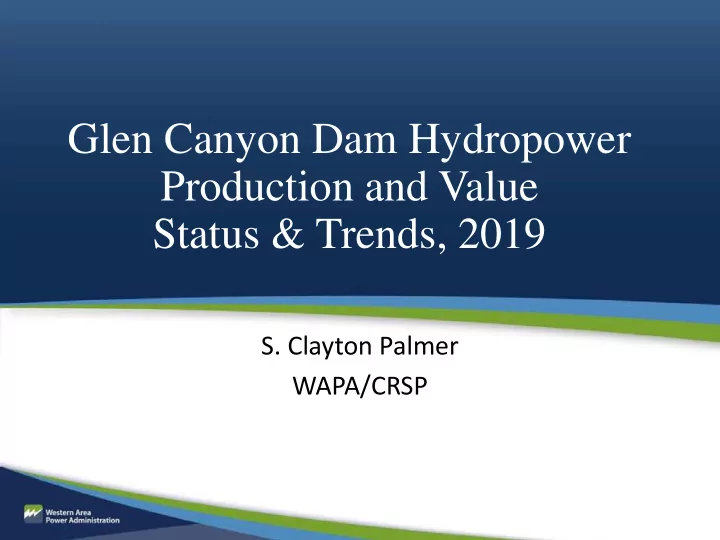

Glen Canyon Dam Hydropower Production and Value Status & Trends, 2019 S. Clayton Palmer WAPA/CRSP
Glen Canyon Powerplant Capacity: 1,320 MW Energy: 3,978 GWhs (10-year average annual)
Status and Trends Recent variables affecting hydropower metrics • Recent decrease in power efficiency [hydropower head = elevation of Lake Powell – elevation of GCD tailrace] Variation in power efficiency effects electrical generation, capacity & net firming purchases • Impacts of the Summer, 2018 Bug Flow Experiment on Hydropower
Hydropower efficiency Presentation title 4
Lake Powell Elevation Affects Power Efficiency: The efficiency in turning Acre Feet into Megawatt hours 3700 3584
Important Lake Powell Elevations EOY 19 3584 Min Power
% of full power head 105.00% 45.00% 55.00% 65.00% 75.00% 85.00% 95.00% Dec-63 Apr-65 Apr, 64 Aug-66 Dec-67 Apr-69 From first electrical production 1963 - 2019 Aug-70 Dec-71 GCD Hydropower Head Apr-73 Aug-74 Dec-75 Apr-77 Aug-78 Dec-79 Apr-81 Aug-82 Jul, 83 Dec-83 Apr-85 Presentation title Aug-86 Dec-87 Apr-89 Aug-90 Dec-91 Apr-93 Aug-94 Dec-95 Apr-97 Aug-98 Dec-99 Apr-01 Aug-02 Dec-03 Mar, 05 Apr-05 Aug-06 Dec-07 Apr-09 Jul, 11 Aug-10 Dec-11 Apr-13 Aug-14 Jul, 1 Dec-15 Apr-17 7 Aug-18 7
% of full power head 100.00% 75.00% 80.00% 85.00% 90.00% 95.00% Apr-99 Oct-99 From the beginning of current drought 1999 - 2019 Apr-00 Oct-00 Apr-01 GCD Hydropower Head Oct-01 Apr-02 Oct-02 Apr-03 Oct-03 Apr-04 Oct-04 Apr-05 Oct-05 Apr-06 Oct-06 Apr-07 Presentation title Oct-07 Apr-08 Oct-08 Apr-09 Oct-09 Apr-10 Oct-10 Apr-11 Oct-11 Apr-12 Oct-12 Apr-13 Mar, 14 Oct-13 Apr-14 Oct-14 Apr-15 Oct-15 Apr-16 Oct-16 Apr-17 Jul, 18 Oct-17 Apr-18 Oct-18 Apr-19 8
% of full power head 76.00% 78.00% 80.00% 82.00% 84.00% 86.00% 88.00% 90.00% Mar-14 Mar, 14 May-14 Jul-14 Sep-14 GCD Hydropower Head Nov-14 Jan-15 Mar-15 May-15 Jul-15 Sep-15 Nov-15 2014 - 2019 Jan-16 Mar-16 May-16 Presentation title Jul-16 Sep-16 Nov-16 Jan-17 Mar-17 May-17 Jul-17 Sep-17 Nov-17 Jan-18 Mar-18 May-18 Jul, 18 Jul-18 Sep-18 Nov-18 Jan-19 Mar-19 Jul, 19 May-19 Jul-19 Sep-19 9
The E e Effect o of f Pow ower E Effic icie iency on G GCD En Energy Producti tion Energy Percentage of Lake Powell production in a Date production vs Elevation 9.0 maf year full powerhead (ft) (GWh) July, 1983 3,707.40 4,617 101.25% Mar., 2005 3,555.90 3,378 74.09% Jan., 2014 3,578.69 3,575 78.39% Jan., 2018 3,619.38 3,916 85.89% Jul., 2019 3,583.66 3,620 79.98%
Summer, 2018 Macroinvertabrate Experiment “Bug flow” experiment Presentation title 11
Development of the experiment • The Bug Flow experiment was developed out of a joint scientific effort to understand the relationship between load-following flows and the aquatic food base. • This cooperative study was joined by GCMRC, Reclamation, WAPA, and Utah State University’s Bug Lab. • Interest in studying low-volume, steady flows were implemented during the weekend, when electrical power has less value in favor of moving water to on-peak hours during the week, when additional power production is needed . • This cooperative effort can serve as a templet of a “Project N” approach to the development of GCD operational experiments. Presentation title 12
Modeling input for the Bugflow Experiment – Summer, 2018 Sunday Monday Tuesday Wednesday Thursday Friday Saturday 13
Illustration of Bug Flows May, 2018 Power release (cfs) 16,000.00 14,000.00 12,000.00 Water relase (cfs) 10,000.00 8,000.00 6,000.00 4,000.00 2,000.00 0.00 May 2018 Presentation title 14
Results of the experiment • The Argonne estimates that the 2018 Bug Flows had a financial impact of $165,000. • This dollar amount is relatively small given the assumptions used in the modeling process. • The 2018 Bug Flow experiment produced benefits to hydropower in the months of May and June, and costs to hydropower in July and August. The month of June turned out to be of particular benefit to hydropower. Presentation title 15
Results (cont.) • These results are a function of the patterning of water releases. • Also, the result reflects the differences between weekday and weekend energy prices. Electrical energy prices are lower, and the weekday/weekend difference is less, in May and June 2018 than they were in July and August 2018. • To arrive at a positive financial outcome to hydropower, weekend electricity prices must be substantially lower than weekday prices. Presentation title 16
The import of the difference between weekday and weekend prices 70 Weighted average Energy Price ($/MWh) 60 50 40 30 20 10 0 May June July Aug. Weekend On-Peak Sale Price Weekend On-Peak Purchase Price Weekday Off-Peak Purchase Price Presentation title 17
Additional considerations • The impact of capacity improvements during weekdays was not included • This is because capacity is – currently – above required capacity margins in the WECC region • A word of caution: • A different set of weekend/weekday prices would produce a different result. Presentation title 18
Questions ?
Recommend
More recommend